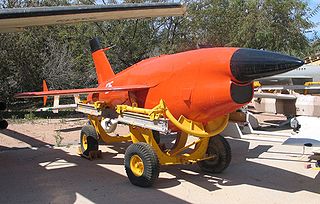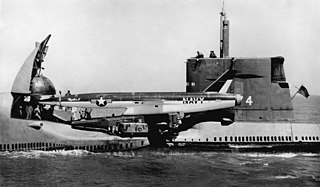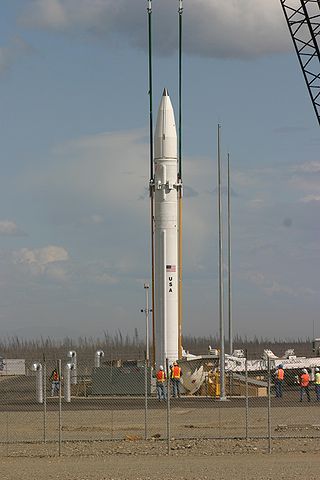
The AGM-88 HARM is a tactical, air-to-surface anti-radiation missile designed to home in on electronic transmissions coming from surface-to-air radar systems. It was originally developed by Texas Instruments as a replacement for the AGM-45 Shrike and AGM-78 Standard ARM system. Production was later taken over by Raytheon Corporation when it purchased the defense production business of Texas Instruments.

A ramjet is a form of airbreathing jet engine that requires forward motion of the engine to provide air for combustion. Ramjets work most efficiently at supersonic speeds around Mach 3 and can operate up to Mach 6.

Northrop Grumman Corporation is an American multinational aerospace and defense technology company. With 95,000 employees and an annual revenue in excess of $30 billion, it is one of the world's largest weapons manufacturers and military technology providers. The firm ranks No. 101 on the 2022 Fortune 500 list of America's largest corporations.

Alliant Techsystems Inc. (ATK) was an American aerospace, defense, and sporting goods company with its headquarters in Arlington County, Virginia, in the United States. The company operated in 22 states, Puerto Rico, and other countries. ATK's revenue in the 2014 fiscal year was about US$4.78 billion.

The Aster 15 and Aster 30 are a Franco-Italian family of all-weather, vertical launch surface-to-air missiles. The name "Aster" stands for "Aérospatiale Terminale", with French company Aérospatiale having been the project's lead contractor before its missile activities were merged into MBDA. It also takes inspiration from the word "aster", meaning "star" in Ancient Greek. The missiles as well as the related weapon systems are manufactured by Eurosam, a consortium consisting of MBDA France, MBDA Italy, both with a combined 66% share, and Thales holding 33%.

The Principal Anti-Air Missile System (PAAMS) is a joint programme developed by France, Italy, and the United Kingdom for an integrated anti-aircraft warfare system. The prime contractor is EUROPAAMS, a joint venture between Eurosam (66%) and UKAMS (33%). In the United Kingdom, PAAMS has been given the designation Sea Viper.
Orbital Sciences Corporation was an American company specializing in the design, manufacture, and launch of small- and medium- class space and launch vehicle systems for commercial, military and other government customers. In 2014, Orbital merged with Alliant Techsystems to create a new company called Orbital ATK, Inc., which in turn was purchased by Northrop Grumman in 2018. The remnants of the former Orbital Sciences Corporation became a subsidiary of Northrop Grumman, known as Northrop Grumman Space Systems.

The Hsiung Feng III is a medium range supersonic missile with capabilities to destroy both land based targets and naval targets developed by the National Chung-Shan Institute of Science and Technology (NCSIST) in Taiwan.

The BQM-74 Chukar is a series of aerial target drones produced by Northrop. The Chukar has gone through three major revisions, including the initial MQM-74A Chukar I, the MQM-74C Chukar II, and the BQM-74C Chukar III. They are recoverable, remote controlled, subsonic aerial target, capable of speeds up to Mach 0.86 and altitudes from 30 to 40,000 ft.

The Minotaur is a family of United States solid fuel launch vehicles derived from converted Minuteman and Peacekeeper intercontinental ballistic missiles (ICBM). They are built by Northrop Grumman via contract with the Air Force Space and Missile Systems Center's Space Development and Test Directorate (SMC/SD) as part of the Air Force's Rocket Systems Launch Program which converts retired Intercontinental Ballistic Missiles into space and test launch systems for U.S. government agencies.

The Ryan Firebee is a series of target drones developed by the Ryan Aeronautical Company beginning in 1951. It was one of the first jet-propelled drones, and remains one of the most widely used target drones ever built.

Castor is a family of solid-fuel rocket stages and boosters built by Thiokol and used on a variety of launch vehicles. They were initially developed as the second-stage motor of the Scout rocket. The design was based on the MGM-29 Sergeant, a surface-to-surface missile developed for the United States Army at the Jet Propulsion Laboratory.

Hypersonic flight is flight through the atmosphere below altitudes of about 90 km at speeds greater than Mach 5, a speed where dissociation of air begins to become significant and high heat loads exist. Speeds over Mach 25 have been achieved below the thermosphere as of 2020.

The RIM-174 Standard Extended Range Active Missile (ERAM), or Standard Missile 6 (SM-6), is a missile in current production for the United States Navy. It was designed for extended-range anti-air warfare (ER-AAW) purposes, providing capability against fixed and rotary-wing aircraft, unmanned aerial vehicles, anti-ship cruise missiles in flight, both over sea and land, and terminal ballistic missile defense. It can also be used as a high-speed anti-ship missile. The missile uses the airframe of the earlier SM-2ER Block IV (RIM-156A) missile, adding the active radar homing seeker from the AIM-120C AMRAAM in place of the semi-active seeker of the previous design. This will improve the capability of the Standard missile against highly agile targets and targets beyond the effective range of the launching vessels' target illumination radars. Initial operating capability was planned for 2013 and was achieved on 27 November 2013. The SM-6 is not meant to replace the SM-2 series of missiles but will serve alongside and provide extended range and increased firepower. It was approved for export in January 2017.

The MA-31 was a conversion of the Kh-31, an anti-ship missile developed by the Soviet Union during the 1980s, for use as a target drone by the United States Navy. Although the missile proved successful in this role, political complications resulted in the type being only an interim solution, and only a small number of the missiles were acquired.

The Type 03 Medium-Range Surface-to-Air Missile or SAM-4 or Chu-SAM is a Japanese developed surface-to-air missile system currently in service with the JGSDF. The SAM's vehicle chassis is based on the Kato Works Ltd/Mitsubishi Heavy Industries NK series heavy crane truck. It uses a state-of-the-art active electronically scanned array radar.

The SSM-N-9 Regulus II cruise missile is a supersonic guided missile armed with a nuclear warhead, intended for launching from surface ships and submarines of the U.S. Navy (USN).

The Ground-Based Interceptor (GBI) is the anti-ballistic missile component of the United States' Ground-Based Midcourse Defense (GMD) system.
Northrop Grumman Innovation Systems (NGIS) was a sector of Northrop Grumman from 2018 through 2019. It was formed from Orbital ATK Inc. a company which resulted from the merger of Orbital Sciences Corporation and parts of Alliant Techsystems in 2015. Orbital ATK was purchased by Northrop Grumman in 2018. Northrop Grumman Innovation Systems designed, built, and delivered space, defense, and aviation-related systems to customers around the world both as a prime contractor and as a merchant supplier. It had a workforce of approximately 12,000 employees dedicated to aerospace and defense including about 4,000 engineers and scientists; 7,000 manufacturing and operations specialists; and 1,000 management and administration personnel. With Northrop Grumman's reorganization of its divisions effective January 1, 2020, NGIS was split, with most of the sector merging with other Northrop Grumman businesses into a new Space Systems sector.

OmegA was a medium-lift to heavy-lift launch vehicle concept that spent several years in development by Northrop Grumman during 2016–2020, with that development substantially funded by the U.S. government. OmegA was intended for launching U.S. national security satellites, as part of the U.S. Department of the Air Force National Security Space Launch (NSSL) replacement program.




















